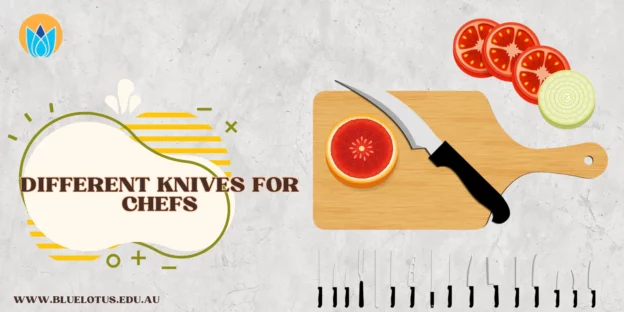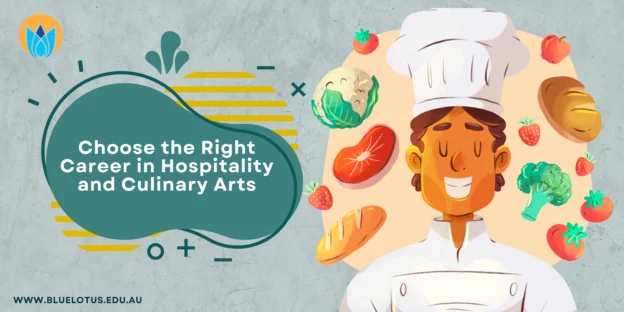Understanding the different types of chef knives and their uses is essential for anyone pursuing a diploma of hospitality management. Whether you are enrolled in VET courses in Melbourne or looking into certificate III in commercial cookery for international students, knowing your knives is crucial. Chef knives are indispensable tools in the kitchen, and their proper use can greatly enhance your cooking skills, making you more efficient and precise in your culinary tasks.
Introduction to Chef Knives
Having the right knife for different culinary tasks is crucial for any chef, particularly those studying cookery courses like the certificate III in commercial cookery Melbourne. Each knife is designed with a specific purpose in mind, and using the appropriate knife can greatly enhance precision, efficiency, and safety in the kitchen.
For instance, using a chef’s knife to chop vegetables allows for quick and consistent cuts, whereas a paring knife excels in more delicate tasks like peeling and trimming. A utility knife offers versatility for mid-sized tasks, and a boning knife ensures precision when cutting meat. Each knife’s design contributes to its functionality, helping chefs work more effectively and with greater control.
Precision is key in cooking, where uniform cuts ensure even cooking and professional presentation. Efficiency is achieved when the right knife speeds up prep time and reduces fatigue. Safety is paramount, as a sharp, well-suited knife minimizes the risk of slips and accidents compared to a dull or inappropriate knife. In this blog, we’ll explore various types of chef knives and their unique uses, helping you understand how each knife can enhance your culinary skills.
Knife Overview Table
| Knife Type | Typical Size (inches) | Primary Uses | Key Features |
|---|---|---|---|
| Chef’s Knife | 8-10 | Chopping, slicing, dicing | Versatile, broad blade, curved edge |
| Paring Knife | 3-4 | Peeling, trimming, detailed cutting | Small, sharp, precise |
| Utility Knife | 5-7 | Slicing fruits, vegetables, small cuts of meat | Intermediate size, versatile |
| Boning Knife | 5-6 | Deboning meat, poultry, fish | Narrow, flexible blade, precision cutting |
| Bread Knife | 8-10 | Slicing bread, tomatoes, cakes | Serrated edge |
| Carving Knife | 8-15 | Slicing cooked meats | Long, thin blade |
| Santoku Knife | 5-7 | Chopping, slicing, dicing | Sharp, straight-edged blade, slightly curved tip |
| Fillet Knife | 6-11 | Filleting fish | Long, flexible blade |
| Steak Knife | 4-6 | Cutting steaks and other meats at the table | Sharp, often serrated blade |
Chef’s Knife: The Workhorse
The chef’s knife is the most versatile and essential tool in any kitchen, particularly for those enrolled in a hospitality management course. Its blade typically ranges from 8 to 10 inches in length, making it ideal for a wide variety of tasks. The broad, sturdy blade allows for efficient chopping, slicing, and dicing of ingredients, making it a reliable workhorse for both professional chefs and home cooks.
Chef’s Knife Uses
| Task | Description |
|---|---|
| Chopping Vegetables | Curved blade enables a rocking motion for efficient cutting |
| Slicing Meats | Length and weight provide leverage for smooth slicing |
| Dicing Herbs | Sharp edge makes quick work of mincing and dicing |
| Multi-Purpose Tasks | Versatility ensures it can handle a multitude of kitchen tasks |
Whether you’re preparing a quick weeknight dinner or an elaborate feast, the chef’s knife proves its worth by handling a multitude of kitchen tasks with efficiency and precision.
Paring Knife: The Precision Tool
The paring knife is defined by its small size, typically 3 to 4 inches in length, which makes it perfect for intricate tasks that require precision and control. This knife excels in delicate and detailed work where larger knives would be cumbersome.
Paring Knife Uses
| Task | Description |
|---|---|
| Peeling Fruits | Sharp, short blade allows for close control |
| Trimming Vegetables | Easily removes stems, blemishes, and small unwanted parts |
| Detailed Cutting | Ideal for deveining shrimp, hulling strawberries, creating intricate garnishes |
The paring knife’s compact size and sharp point enable chefs to perform tasks that require a high degree of accuracy, making it an indispensable tool for any kitchen focused on precision and detail.
Utility Knife: The All-Purpose Knife
The utility knife is the all-purpose tool of the kitchen, bridging the gap between the larger chef’s knife and the smaller paring knife. Its intermediate size, typically 5 to 7 inches in length, makes it incredibly versatile for a wide range of tasks.
Utility Knife Uses
| Task | Description |
|---|---|
| Slicing Fruits | Offers more control than a chef’s knife for mid-sized produce |
| Cutting Vegetables | Handles small to medium-sized vegetables with ease |
| Small Meat Portions | Ideal for trimming fat, slicing chicken breasts |
| Versatile Tasks | Adapts to many kitchen tasks, making it a go-to tool |
The utility knife’s adaptability ensures it can handle almost anything, making it a must-have in any well-equipped kitchen.
Boning Knife: For Precision Meat Cutting
The boning knife is characterized by its narrow, flexible blade, usually ranging from 5 to 6 inches in length. This design allows it to maneuver around bones and joints with ease, making it an indispensable tool for tasks that require precision in cutting meat.
Boning Knife Uses
| Task | Description |
|---|---|
| Deboning Meat | Sharp point and thin blade make precise cuts close to the bone |
| Filleting Fish | Flexibility allows smooth cuts along the bone structure |
| Skinning Meat | Separates skin from meat with precise control |
| Trimming Fat | Removes silverskin and fat without wasting meat |
For any chef serious about their meat preparation, a boning knife is essential. Its ability to perform detailed, precise cuts makes it a vital tool in ensuring that meat is prepared with the utmost care and efficiency.
Bread Knife: The Serrated Edge
The bread knife is easily identifiable by its long, serrated blade, typically 8 to 10 inches in length. The serrations allow it to cut through bread without crushing it, maintaining the loaf’s integrity. This knife is also excellent for slicing through foods with a hard exterior and soft interior, such as tomatoes and cakes.
Bread Knife Design and Uses
| Feature | Description |
|---|---|
| Long Blade | Typically 8 to 10 inches in length, providing the reach needed for slicing large loaves of bread. |
| Serrated Edge | The serrated blade easily cuts through crusty exteriors without compressing the soft interior. |
| Straight or Curved Blade | Available in both straight and slightly curved designs to accommodate different slicing techniques. |
Typical Uses of Bread Knife
| Use | Description |
|---|---|
| Slicing Bread | The serrated edge cuts through bread without crushing, ensuring even slices and maintaining texture. |
| Cutting Tomatoes | Ideal for slicing tomatoes, allowing for smooth cuts through the skin and soft interior without squishing. |
| Cake Cutting | Perfect for slicing cakes, especially those with delicate layers, without damaging their structure. |
Carving Knife: For Perfect Slices
The carving knife features a long, thin blade, usually between 8 to 15 inches in length. It is designed for slicing cooked meats, such as roasts, turkey, and ham. The length and flexibility of the blade allow for smooth, even slices, ensuring that each piece is cut to perfection without tearing the meat.
Carving Knife Design and Uses
| Feature | Description |
|---|---|
| Long Blade | Typically 8 to 15 inches in length, providing the reach needed for slicing large cuts of meat. |
| Thin Blade | The thinness of the blade allows for precise, clean cuts, reducing tearing and preserving the meat’s texture. |
| Flexible Blade | Slight flexibility helps in following the contours of the meat, ensuring uniform slices. |
Typical Uses of Carving Knife
| Use | Description |
|---|---|
| Slicing Roasts | The long, thin blade allows for smooth, even slices of roasts, ensuring uniform pieces for serving. |
| Carving Poultry | Perfect for carving turkey and chicken, providing clean cuts without tearing the meat. |
| Cutting Ham | Ideal for slicing ham into thin, even pieces, enhancing presentation and texture. |
| General Meat Slicing | Suitable for any large, cooked meats requiring clean, thin slices for serving. |
Carving Knife Uses Table
| Knife Type | Primary Uses | Key Features |
|---|---|---|
| Carving Knife | Slicing roasts, carving poultry, cutting ham, general meat slicing | Long, thin blade (8-15 inches); flexible for precise cuts |
The carving knife’s design ensures that it excels in tasks requiring smooth, clean slices, making it an indispensable tool for chefs and home cooks who frequently prepare large cuts of meat.
The Heavy-Duty Cutter
The cleaver is a heavy, broad-bladed knife known for its robust construction and versatility in the kitchen. It is a powerful tool designed to handle tasks that require significant force and precision, making it essential for cutting through bones, chopping large pieces of meat, and handling tough vegetables.
Cleaver Design and Uses
| Feature | Description |
|---|---|
| Heavy Blade | The weight of the cleaver allows it to cut through bones and tough meat with ease. |
| Broad Blade | Provides a large surface area for chopping and crushing, as well as for scooping up chopped ingredients. |
| Robust Construction | Built to withstand heavy-duty tasks, ensuring durability and longevity. |
Typical Uses of Cleaver
| Use | Description |
|---|---|
| Cutting Through Bones | The heavy blade can easily cut through bones, making it ideal for butchering and preparing large cuts of meat. |
| Chopping Large Pieces of Meat | Efficiently chops through large and tough pieces of meat, such as pork shoulders or beef briskets. |
| Handling Tough Vegetables | Perfect for chopping and splitting tough vegetables like squash and pumpkin. |
| Crushing Garlic and Ginger | The broad side of the blade can be used to crush garlic cloves and ginger, making prep work faster and easier. |
Cleaver Uses Table
| Knife Type | Primary Uses | Key Features |
|---|---|---|
| Cleaver | Cutting through bones, chopping large pieces of meat, handling tough vegetables, crushing garlic and ginger | Heavy, broad blade; robust construction |
The cleaver’s design and functionality make it an indispensable tool for tasks that require both power and precision, providing versatility and efficiency in the kitchen.
Santoku Knife: The Japanese All-Rounder
The Santoku knife is a versatile Japanese knife known for its shorter, wider blade compared to the chef’s knife. Typically ranging from 5 to 7 inches in length, the Santoku knife excels in chopping, slicing, and dicing with a focus on precision and speed. Its design and origin make it a valuable tool in both professional and home kitchens.
Santoku Knife Design and Uses
| Feature | Description |
|---|---|
| Shorter Blade | Typically 5 to 7 inches in length, making it more maneuverable and precise for detailed tasks. |
| Wider Blade | The wider blade allows for efficient scooping and transferring of chopped ingredients. |
| Flat Edge | The blade has a flat edge and a slightly curved tip, ideal for a downward slicing motion. |
| Japanese Design | Reflects traditional Japanese craftsmanship, focusing on balance, precision, and efficiency. |
Typical Uses of Santoku Knife
| Use | Description |
|---|---|
| Chopping Vegetables | The short, wide blade allows for precise chopping of vegetables, making it easy to create uniform pieces. |
| Slicing Meat | Perfect for slicing meat into thin, even pieces, whether raw or cooked. |
| Dicing Ingredients | Ideal for dicing a variety of ingredients, ensuring uniformity and speed. |
| General Food Prep | Versatile enough for a wide range of kitchen tasks, from cutting herbs to preparing fish. |
Santoku Knife Uses Table
| Knife Type | Primary Uses | Key Features |
|---|---|---|
| Santoku Knife | Chopping vegetables, slicing meat, dicing ingredients, general food prep | Shorter, wider blade (5-7 inches); flat edge; Japanese design |
The Santoku knife’s unique design and multifunctional capabilities make it an essential tool for chefs and home cooks who value precision, efficiency, and versatility in their kitchen tasks.
Summary of the Uses and Features of Different Knives
| Knife Type | Primary Uses | Key Features |
|---|---|---|
| Chef’s Knife | Chopping, slicing, dicing, mincing | 8-12 inch blade; balanced; versatile |
| Paring Knife | Peeling, trimming, detailed tasks | 3-4 inch blade; short; precise |
| Bread Knife | Slicing bread, cutting tomatoes, cake cutting | 8-10 inch serrated blade; long; even cuts |
| Carving Knife | Slicing roasts, carving poultry, cutting ham, general meat slicing | 8-15 inch thin blade; flexible; precise cuts |
| Cleaver | Cutting through bones, chopping large pieces of meat, handling tough vegetables, crushing garlic and ginger | Heavy, broad blade; robust construction |
| Santoku Knife | Chopping vegetables, slicing meat, dicing ingredients, general food prep | Shorter, wider blade (5-7 inches); flat edge; Japanese design |
Conclusion
Understanding the different types of knives and their uses is fundamental for any chef, especially those enrolled in cookery courses in Melbourne. Each knife serves a unique purpose, and mastering them can significantly improve your efficiency and precision in the kitchen. Whether you’re slicing, dicing, or filleting, having the right knife for the job will enhance your culinary experience and help you create dishes with professional-level finesse.
If you’re passionate about improving your culinary skills and gaining industry knowledge, consider enrolling in one of the hospitality courses at Blue Lotus College. With comprehensive training in kitchen management and advanced culinary techniques, these courses are designed to equip you with practical skills for a successful career in the culinary world.
| Course | Description |
|---|---|
| Certificate III in Commercial Cookery | Foundational cookery skills for aspiring chefs |
| Certificate IV in Kitchen Management | Advanced kitchen management skills |
| Diploma of Hospitality Management | Comprehensive training in hospitality management skills |
| Advanced Diploma of Hospitality Management | Advanced training in hospitality management and culinary techniques |
Enhance your culinary journey by exploring these cookery courses that are designed to provide practical skills and industry knowledge for aspiring chefs and hospitality professionals. Take the next step in your culinary journey and enroll in a course at Blue Lotus College today!
More Helpful Resources
- How to Succeed in Certificate III in Commercial Cookery in Australia?
- Sous Chef: Roles, Skills, Qualifications, Salary, and Career in 2024
- How to Choose the Right Career in Hospitality and Culinary Arts in Melbourne
- Certificate IV in Kitchen Management: A Stepping Stone to Your Culinary Career in Melbourne
- Mastering the Art: A Comprehensive Guide to Commercial Cookery in Australia
- How to Choose the Right Career in Hospitality and Culinary Arts in Australia
- Top 5 Cookery Courses in Australia for International Students



